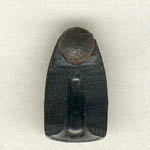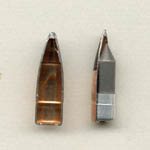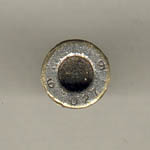Home
Constructions
Construction
Projectile
Head stamps
Colour markings
Ammunition
Articles
| The Projectile.
Ball projectile
The ball projectile is the base platform of all projectiles, no fuzz, no extra function but to have as good trajectory as possible and being as accurate as possible. The earliest projectiles were formed out of lead. The functionality was not that good as the material was too soft to grip the rifling at higher velocity, and it did also foul the barrel. The solution was to use a metal jacket around the core making a big leap in velocity and also improving the precision at longer distances.
Gallery projectile
The gallery practice ammunition is made for short range practice for no more than about 30 meters.
Gallery practice ammunition is found in the calibers 6,5x55, 7,62x51 and in 9x19. The 6,5x55 and 7,62x51 projectile is made in the same way. It is a small piece of jacket, sometimes with a wooden core and sometimes without core and weighs about 0,5 grams.
The 9x19 projectile is made out of plastic with a 5,2mm steel ball in the front. 9x19 gallery practice ammunition is only used with Submachine gun m/45 and m/45B with the blank firing barrel mounted but without the blank firing device. The plastic part of the projectile is shredded in the barrel, and it’s the steel ball that hits the target.
 |
 |
| 9x19 |
6,5x55 |
Blank ammunition.
The blank projectile is made of wood or wood powder and plastic mixed. At the front of the weapon is mounted a blank firing device that shreds the bullet at exit. The exception is the blank firing ammunition for PSG90 that have a case without bullet. The PSG90 do not have a blank firing device.
Tracer projectile
The tracer projectile gives a bright light that makes it easy to follow its trajectory. That can be used for different purposes as to give fire control to a machine gun or to point out to your troop mates where the enemy is hiding. It is also scary for the enemy to see the projectiles headed for them. It’s freighting enough to hear the projectiles without seeing them too!
The tracer projectile is built like a ball projectile with a jacket and a lead core but with a tracer compound in the rear. The tracer compound is made of magnesium that gives a bright light when it burns. PVC is used as a binder. They use either strontium for a red light or barium for a green light.
 |
 |
| 9x19 |
7,62x51 |
Incendiary projectile
At a hit on a hard or armored
target, the friction sensitive compound inside the jacket burst to flames
for just a second or two, enough time to ignite any flammable materials.
The heat is high enough to ignite diesel. What I know the incendiary projectile has only been used in 8x63 and in .50 calibre ammunition.
Armor piercing projectile
The Armor piercing projectile
is as the name says, mainly made against hard targets. It's made to penetrate lightly armored vehicles, airplanes and covers. This is made by putting in a hard core in the projectile, made of hard steel or Tungsten. What normally happens when a ball projectile hits a hard target is that the projectile is deformed without penetrating the target. By using a hard core the core is more easily pushed into the target without deforming.
The latest and best projectile in 7,62 may penetrate more than 15 mm steel
at 300 meters.
 |
| 7,62x51AP |
Sniper projectile (sub
caliber)
The latest projectile for
sniping is of sub caliber. The ammunition have the caliber of 7,62x51, but the projectile have a caliber of 4,81 mm. The projectile is kept in place
in a standard cartridge by a sabot made of plastic and aluminum. When
the projectile and the sabot left the barrel the sabot falls to the ground
after a job well done. The sub caliber projectile travels with a higher speed
than the standard ball projectile (Ca 1340mps compared against 785mps).
The slim projectile is less sensitive to wind and have a straighter trajectory
than the ball projectile. Therefore the shooters don't have to compensate
as much for weather, wind and range which increases the hit probability
considerable. The projectile is made of Tungsten that is considerable harder
and heavier than steel. The combination of a hard material, small caliber
and high speed makes the ammunition very good on hard targets. It will
penetrate more than 20 mm steel at 300 meters.
 |
| 7,62x51
Prick |
Inert round
The inert round is a practice
round. The green marked round is made in such a way that it is impossible
to remake it to a live round. Normally it has two or three grooves in the
case to make it more difficult to exchange the round with a live cartridge
and vice versa. The round is used to practice loading and unloading in
a safe way.
 |
 |
 |
| 9x19
Inert round |
7,61x51
Inert round |
|
Copyright © 2000 Chris
The Swedish military ammunition site
|